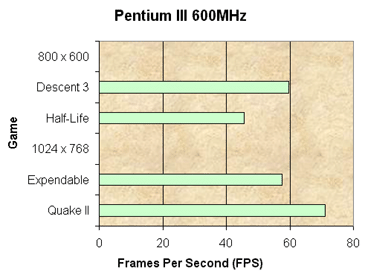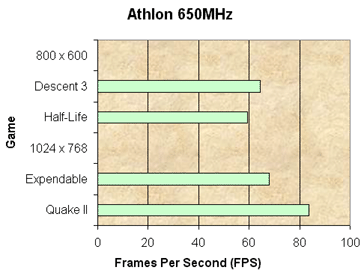 |
|
|
|
In the Forums... |
Posted: April 12, 2000 Written by: Tuan "Solace" Nguyen Benchmark System Bench System: 600MHz Pentium III, Asus P2B-F Rev. 2.04 (440BX AGPset) with BIOS-1010. 128MB SEC 100MHz (8ns) SDRAM - unbuffered Quantum 8.4GB CR UltraDMA 33 Harddrive Diamond Monster Sound MX300 (latest A3D reference drivers) Fresh install of Windows 98 SE Diamond Viper V770 Ultra (nVidia Detonator drivers ver. 2.08) 650MHz Athlon, MicroStar 6167 (Irongate 750). 128MB SEC 100MHz (8ns) SDRAM - unbuffered Quantum 8.4GB CR UltraDMA 33 Harddrive Diamond Monster Sound MX300 (latest A3D reference drivers) Fresh install of Windows 98 SE Diamond Viper V770 Ultra (nVidia Detonator drivers ver. 2.08) All benchmarks are run with V-Sync and sound on for realistic performance and usage conditions. Test Programs: NU4 System Information benchmark Quake II (1024 x 768) Half-Life (800 x 600) Expendable (1024 x 768) Descent 3 (800 x 600) All testing is done using 32-bit color enabled. Here's benchmarks we did on our test systems to show you how the Pentium III 600MHz fairs with an Athlon 650MHz. Unfortunately at the time of testing, Intel had not released a 650MHz Pentium III. To measure a video card's performance, we measure in frames per second (fps) in a variety of popular real-world games. Quake II is the OpenGL standard. Quake III Arena will be our next OpenGL base tester when the real-world game arrives. Half-Life is based upon the Quake II engine but is supped up to use more detailed models with higher polygon counts and texture maps. Expendable is a Direct3D Olympic event packed with multi-texturing effects. Descent 3's indoor and outdoor Fusion engine pumps polygons and colored lighting that saturates the video pipeline.   As you can see from the scores, the Athlon outperforms the Pentium III in raw performance. These games leverage floating point calculations. As you can see the Athlon is no slouch in terms of FP calculation. |
||
|
| |||
|---|---|---|---|